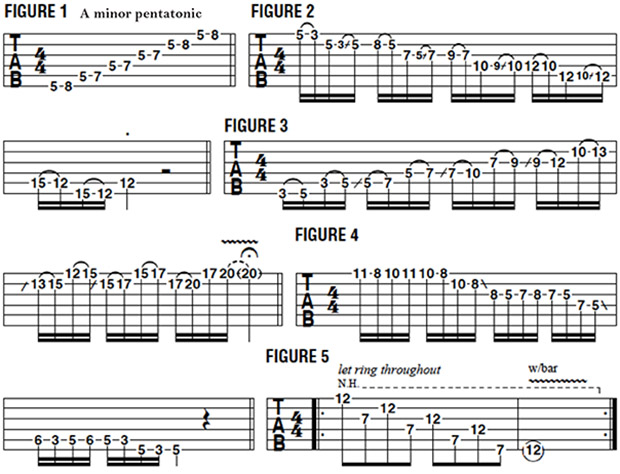Pentatonic Trailblazing: How to Navigate Through a Familiar Scale to Produce Fresh-Sounding Licks

In this month’s column, I’d like to demonstrate a variety of ways to twist that staple scale heard in virtually all rock and metal solos—the trusty old five-note pentatonic scale—into new and unusual phrases and patterns.
I was initially inspired to come up with these licks from a conversation I had with a saxophone player who asked me, “Why do so many guitarists always play pentatonic runs exactly the same way?”—meaning, why do most guitarists play up and down through the pentatonic scale within the confines of a single fretboard position? He pointed out, “Every time you guys play a solo, your fingers all look the same!”
I thought about that and realized that he had a legitimate point, so I set out to come up with a bunch of licks that ascend and descend the fretboard with unexpected finger slides and position shifts that, by their very nature, create a smooth, legato sound that is more “horn-like” than the typical, stock lead guitar phrases we are all so familiar with.
The first two licks I’m going to show you are based on A minor pentatonic, which is outlined in ascending form in fifth position in FIGURE 1. FIGURE 2 illustrates a lick, played in steady 16th notes, that is based on a sequence of four-note descending “cells” that gradually move up the fretboard on each successive beat from one position, or “box,” of A minor pentatonic to the next. The trick here is that the last note of each four-note “cell” includes a quick finger slide up to the next position. Throughout this lick, I keep my fret-hand fingers arched so that they’re set directly above the frets, parallel with the fretwire.
This way, I can easily focus on my fretting technique, making sure that each note is fretted cleanly and will sound loud and clear. As you play through FIGURE 2, note that the index finger does all the upward sliding as we move from beat to beat. Additionally, you’ll see that I pick the first note on each string and then sound the following note with a pull-off. The only really tricky part of this phrase is found on beat two into beat three, as beat two begins with a pinkie pull-off and beat three begins with a ring finger pull-off. Sometimes it can feel weird switching fingers like this, so give special attention to this part of the phrase by “looping” these two four-note cells over and over.
Now let’s apply this approach to an ascending phrase (see FIGURE 3). This run is similarly constructed with successive four-note cells that ascend from one position of A minor pentatonic to the next, via a series of index-finger slides, but it involves the use of hammer-ons instead of pull-offs. The only potentially tricky part of this lick falls on beat four of bar 1, for which a wide index-to-pinkie hammer-on move has to jump quickly from ninth position to 10th position.
FIGURE 4 is built from a pattern, based on the A blues scale (A C D Eb E G), that’s played in three different octaves and fretboard positions. Using alternate picking, I play an initial eight-note melodic sequence across the top two strings in eighth position. I then quickly shift down to fifth position and play the same pattern on the middle two strings, then finally shift down to third position and do the same thing on the bottom two strings, using the same fretting and fingering scheme in each successive octave. Let’s wrap up with a riff based on E minor pentatonic (E G A B D), performed entirely with natural harmonics (see FIGURE 5). Be sure to allow all notes to ring together as much as possible.

Get The Pick Newsletter
All the latest guitar news, interviews, lessons, reviews, deals and more, direct to your inbox!







![Joe Bonamassa [left] wears a deep blue suit and polka-dotted shirt and plays his green refin Strat; the late Irish blues legend Rory Gallagher [right] screams and inflicts some punishment on his heavily worn number one Stratocaster.](https://cdn.mos.cms.futurecdn.net/cw28h7UBcTVfTLs7p7eiLe.jpg)


